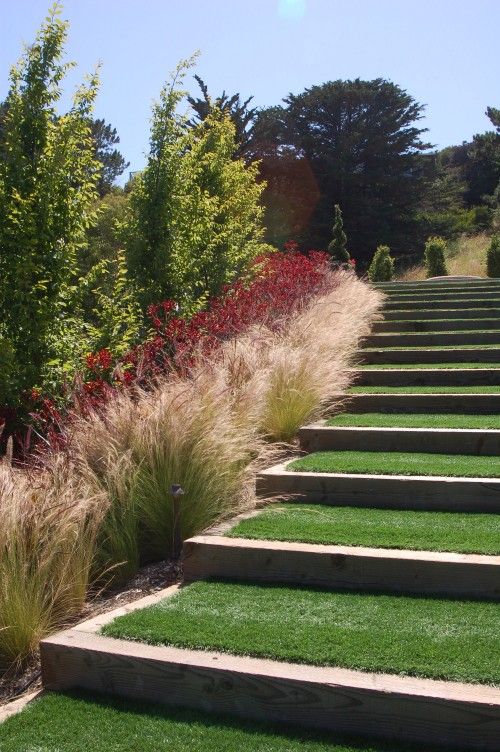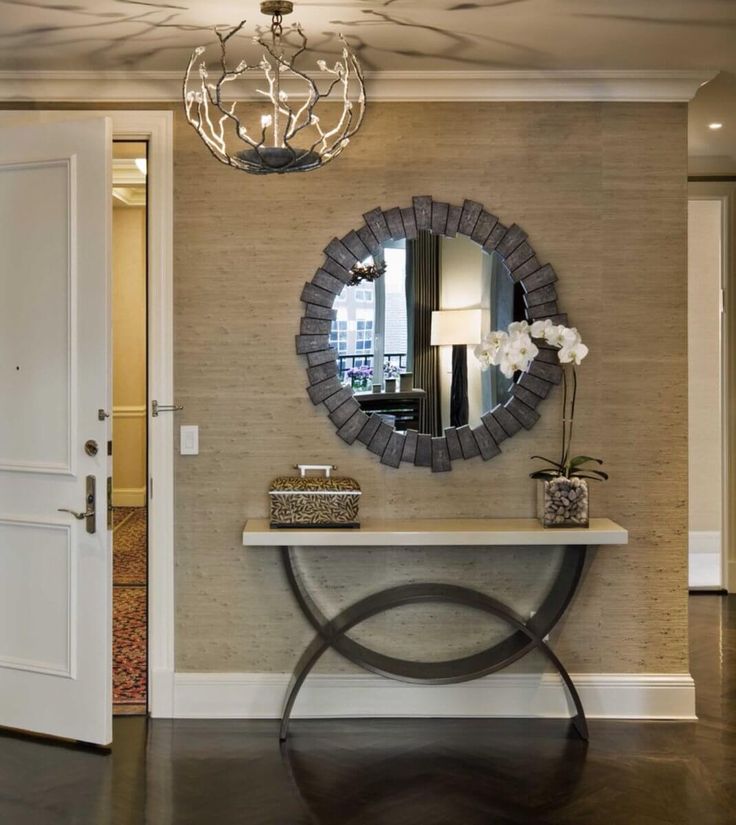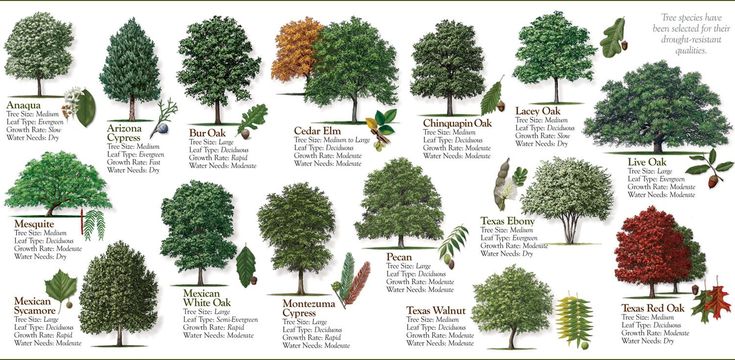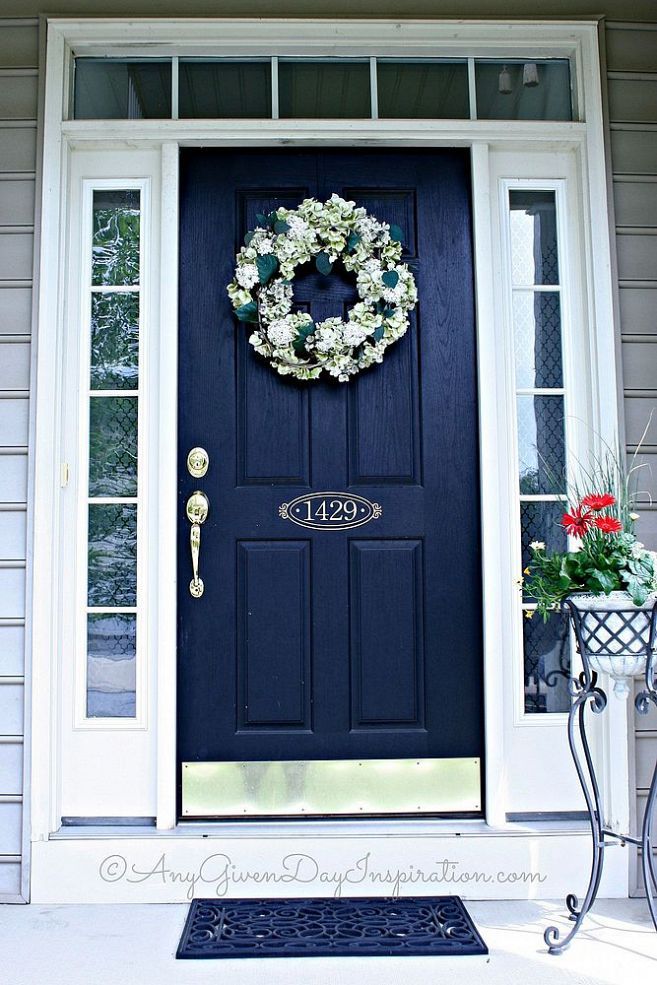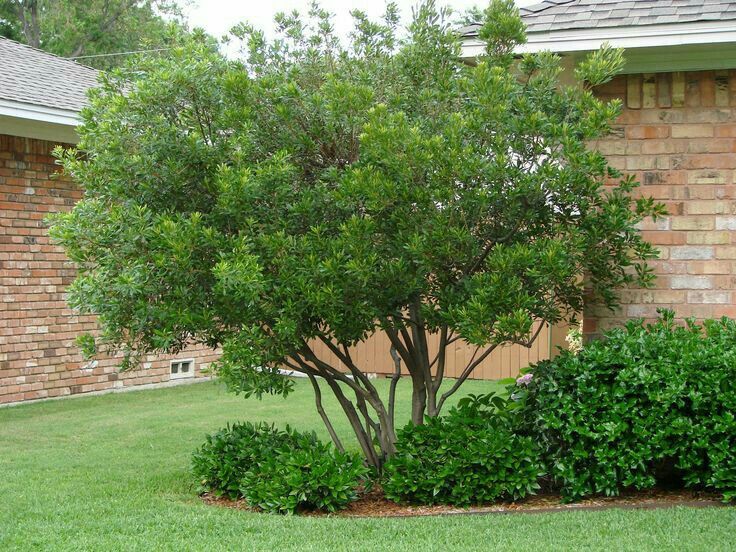Designing gardens on slopes
How to design a sloping garden: key points to consider
(Image credit: Acres Wild Landscape and Garden Design/ Ian Smith)
There are myriad options for how to design a sloping garden that make the most of a backyard on a gradient. Far from presenting limitations, you can use inclines to your advantage as a sloping backyard offers fabulous layout and planting options that would not be possible to achieve on a flat site.
With variable levels, you can create distinct garden areas, each with their own purpose, ambiance and planting scheme, as well as a variety of seating areas in which to sit and drink in the views below or above.
Budget is important when designing any garden, but particularly so with sloping garden ideas, where if you don't plan things out carefully costs can escalate.
There are a number of key elements to consider when planning a design for a sloping garden that can also link in to other backyard ideas.
(Image credit: Future / Annaick Guitteny)
Plan the designs for a sloping garden to fit the lie of the land, and work with the natural topography of your backyard.
‘A sloping garden presents unique design opportunities to create either drama or subtlety. Finding the route through the slope is just as important as the overall effect,’ explains John Wyer, CEO and lead garden designer at Bowles & Wyer .
Incorporate pathways running along the slope, linking sets of steps or terraces. 'This offers a delightful and ever-changing perspective of the garden, as well as multiple opportunities to get your nose in the flowers!' adds John Wyer.
(Image credit: Elks-Smith Garden Design)
How do you plan a sloping garden?
‘Don’t be in a rush to flatten the ground in designs for a sloping garden, as changing levels offers so much potential,’ explains garden designer Helen Elks-Smith .
'If you are lucky enough to have a site with gentle undulations, following natural contours or tweaking existing ones is a wonderful way to add visual interest and interesting walks around the garden. Simple grass banks can also be utilized to retain sloping soil,’ Helen adds.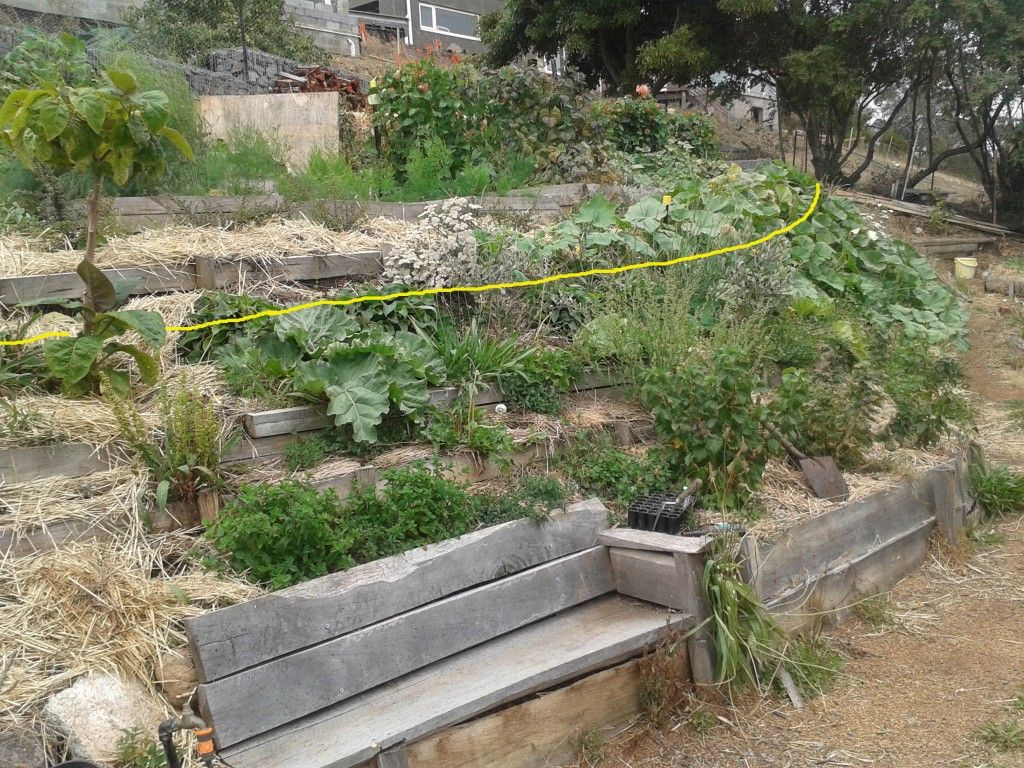
However, in tackling a steep site you do need to call on the expertise of the professionals.
'You will inevitably need a structural engineer’s input, as there will be a lot of soil to retain. Subtle, discreet terracing may also need to be designed and incorporated by an experienced landscaper,' explains garden designer Sara Jane Rothwell .
(Image credit: Elks-Smith Garden Design)
This is where a mix of patio ideas and deck ideas can be worked into your design to create the perfect layout.
'It's usually a question of planning different levels in places that are right for the location and aspect of your garden,' says says garden designer and writer Ruth Chivers, and co-author of Designing Gardens on Slopes .
'For example, creating a level paved area to sit out on is an essential, but whether you want this to be in full sun at a certain time of day will affect where you decide to make the terrace or patio.
'Views from inside your house out to the garden are as important as views from within the garden and beyond it,' she adds.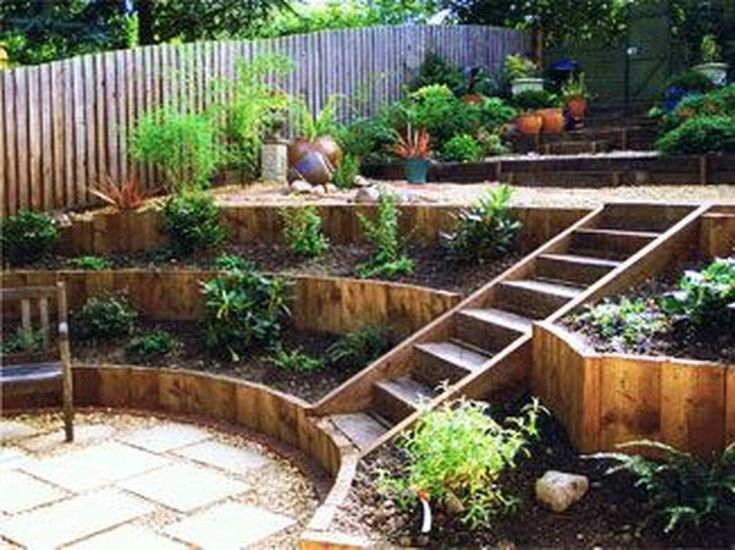
How can staircases become a feature of a sloping garden?
(Image credit: Bowles & Wyer Garden Design)
Rather than using more traditional terracing, use staircases to link levels of the back yard to become a feature in their own right in designs for a sloping garden.
‘Think of the grand staircases and terraces in Italian renaissance gardens. While we might not be able to replicate that scale and grandeur in our gardens, we can take inspiration from their designs,’ says John Wyer.
You can make a statement with sweeping sets of steps leading up to an upper level, possibly a seating area, bench, or even a piece of sculpture.
(Image credit: Steven Wooster / Bowles & Wyer)
If you are designing for a traditional space you may want to use a stone that blends with and is complementary to the house.
But for a modern take on a traditional staircase, think outside the box when it comes to materials to use for the steps.
Consider how a material that contrasts with the surrounding greenery, such as contemporary grey stone, can make more of an impact, 'with staggered step lengths creating interest,' adds John.
(Image credit: Sara Jane Rothwell)
Steps need not be constructed from stone, but could also incorporate other materials.
'We designed this garden (above) with wide gravel and Corten Steel steps. Corten Steel is a very versatile material; it is strong and fairly straightforward to instal. Any joins will be hidden behind the rusty patina that will build up over time and it weathers naturally,' explains Sara Jane Rothwell.
The color of the Corten Steel also complements the surrounding planting. Allowing plants in herbaceous borders to spill over the edges of steps and risers, helps to soften the straight lines.
What do I do with a steep bank in my garden?
(Image credit: Ann-Marie Powell Gardens)
‘Planting up a slope, although a challenge, is a great opportunity to play with perspective,' explains designer Ann-Marie Powell .
'Tall plants are often planted at the back of borders, but plant heights need to be considered in relationship to where you are viewing the border from, as you don’t want to block the border views.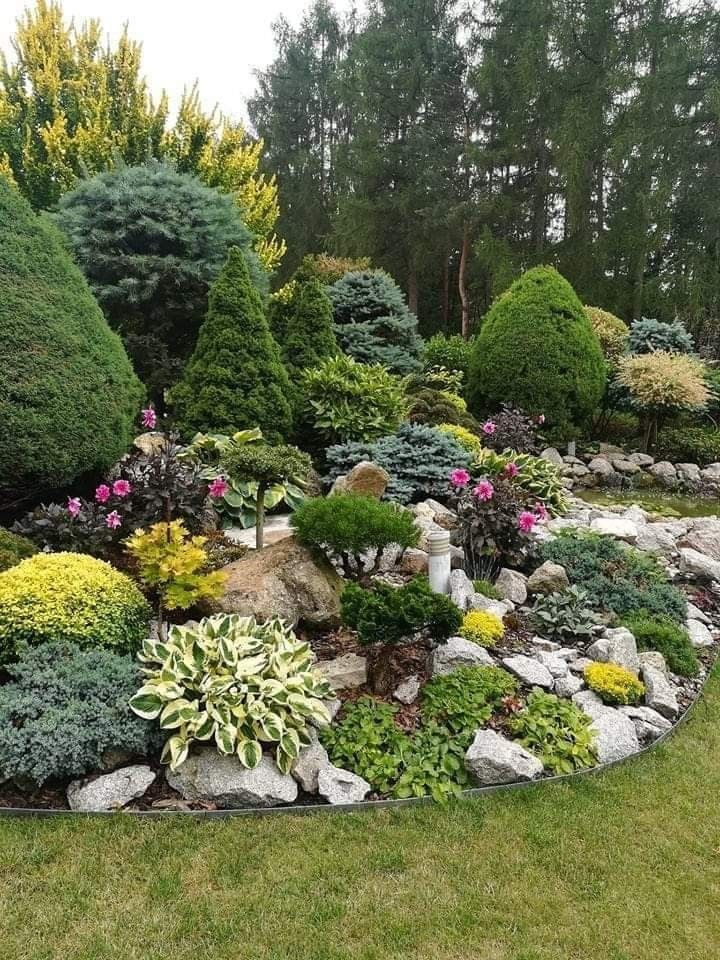 '
'
Successive sweeps of foliage and flowers can build on one another creating multiple perspectives in designs for a sloping garden. Plants of the same height will appear taller as your eye travels up a slope, creating the illusion of layered planting.
(Image credit: Ann-Marie Powell Gardens)
‘Select the right plants which will cope with water run off, as rain naturally travels down a gradient,' adds Ann-Marie Powell.
On a sunny slope, consider plants which will cope with dry soil conditions, such as grasses, verbena, euphorbia, gaura, achillea and others often considered gravel plants, or used for creating a Mediterranean garden.
'When planting, we’ll often use a mini-ditch around the plant, which will collect water and so allow plants a moisture sump to draw from.
'Those plants which enjoy conditions with higher moisture levels can be planted at the bottom of the slope where the gradient is less steep and where there is less chance of soil and nutrients being washed away,’ Ann-Marie adds.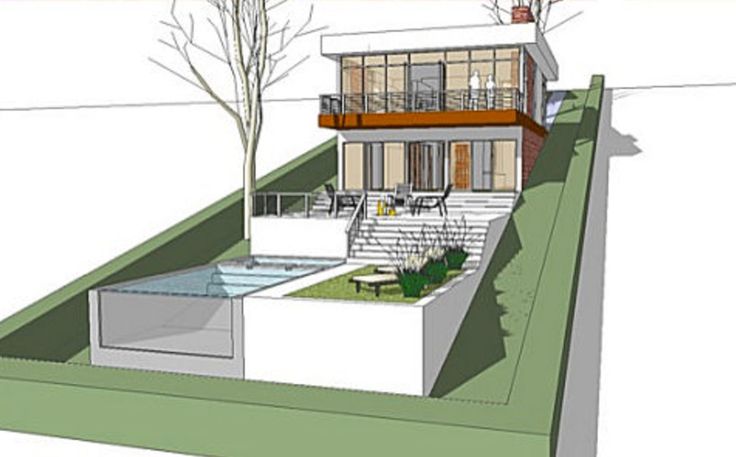
(Image credit: Future / Mark Bolton)
'Certain plants can help with the problem of soil erosion on slopes,' says Ruth Chivers.
'Sloping areas need more plants to cover the ground.' Some useful low growing plants include:
- Acaena
- Bergenia
- Cotoneaster congestus ‘Nanus'
- Cytisus kewensis
- Helianthemum
- Hardy geraniums
'Choose grasses that have a spreading growth habit rather than clump forming – these add a lovely sense of movement in the wind,' adds Ruth.
It is easy to get to grips with growing ornamental grasses and Ruth suggests among good options for a sloping site are Carex divulsa, hakonechloa and the prairie dropseed, Sporobolus heterolepis.
(Image credit: Acres Wild Landscape and Garden Design/ Ian Smith)
Allow the planting to prevail, and capitalize on the garden slope provided to serve as 'a wonderful theatrical ramped stage to showcase cascading layers of planting,' says Sara Jane Rothwell.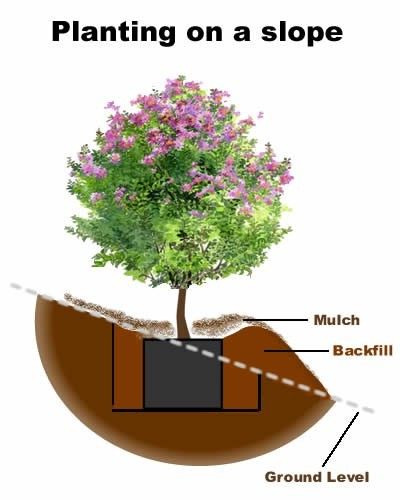
Create soft, undulating rhythm with repeated planting for a restful composition.
Lastly, 'maintenance is also something to consider – a gardener's path through large beds will make it easier for you to weed, feed and cut back when required,' advises Ann-Marie Powell.
When do you need to use retaining walls?
(Image credit: Mark Bolton)
‘Often a key requirement for clients in designs for a sloping garden is the need to have some flat, usable spaces. But remember that you can’t change levels at the boundaries or around existing trees,' explains Debbie Roberts of Acres Wild Landscape and Garden Design .
The ‘cut and fill’ method to dig out and level a slope makes the best use of the soil on site, 'as it is expensive to bring soil in or take it away,’ explains Debbie.
This involves digging out soil to lower the top half of the area, and using the same soil to fill the lower half.
You will then need to consider how to deal with the resultant slopes.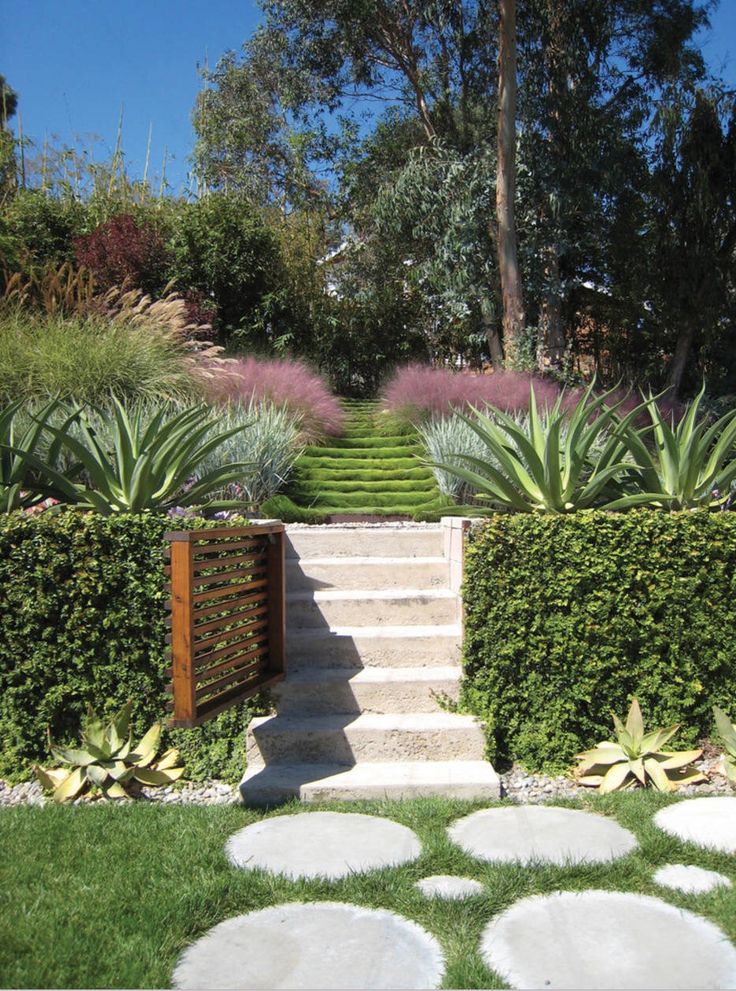
(Image credit: Bowles & Wyer)
'Retaining walls essentially hold up the rest of the garden, so require heavy reinforcement, to strict calculations, to take the strain,' explains Sara Jane Rothwell.
Due to the expert engineering required, retaining walls are, inevitably, expensive.
'Retaining walls can become a feature in their own right, or be concealed behind planting,' adds Sara Jane.
'Drainage is also key on a steep slope, and a series of underground drains and channels can be incorporated within a design to carry the water away.'
(Image credit: Bowles & Wyer)
'If retaining walls are necessary, where to place them so their height is not oppressive is really important,' says Ruth Chivers.
You could create a more gradual, terraced effect 'using a combination of low banks and walls, as this will result in a much softer and less "engineered" appearance,’ says Debbie Roberts.
Retaining walls, much like garden wall ideas, can be made from all manner of materials, from wood and stone, to concrete or bricks.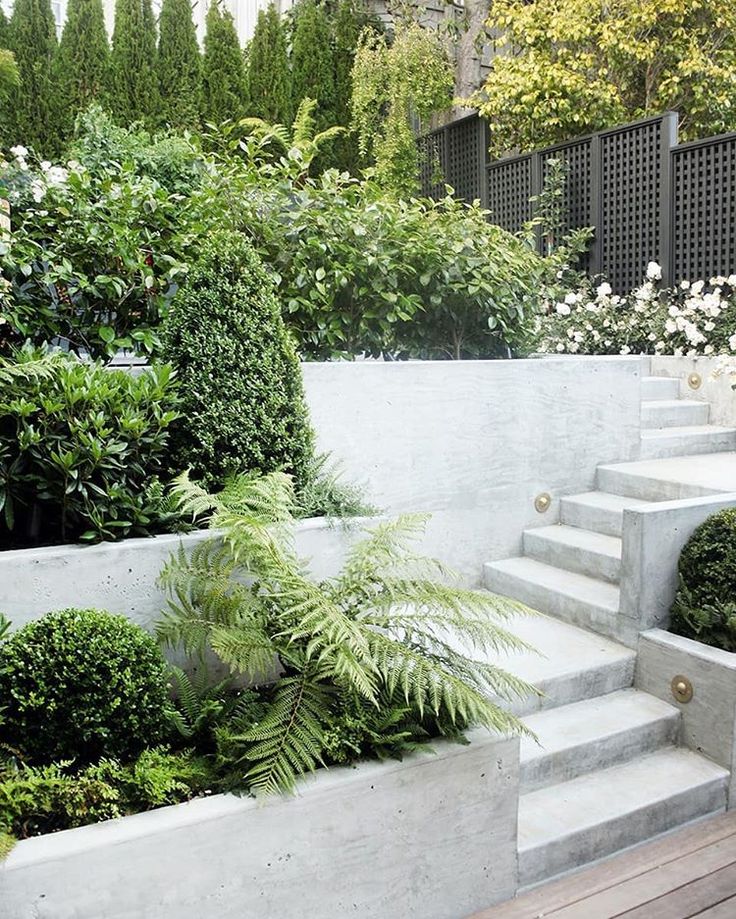
'Stone-filled gabion walls provide structure, as well as an interesting visual pattern, which can be contrasted with layered textural planting,' explains John Wyer.
How do you landscape a steep slope without retaining walls?
(Image credit: Acres Wild Garden Design/ Debbie Roberts)
'Planting up a slope is a really great, sustainable, low environment-impact opportunity to do away with the hard lines and expense of retaining walls and fill a graded landscape with a plethora of biodiversity enhancing, carbon locking, beautiful plants,' says Ann-Marie Powell.
‘Where a steeper change of level is needed, we generally create banks for planting,’ agrees designer Mandy Buckland of Greencube Landscapes .
(Image credit: Greencube Landscape and Garden Design)
'We recently used motorway stabilizing geosynthetics – Terram – this creates pockets for plants once soil has graded back in the stabilizing material,' adds Mandy Buckland.
So do not be deterred by a sloping garden, but use inclines to your advantage and discover the many design opportunities a slope offers.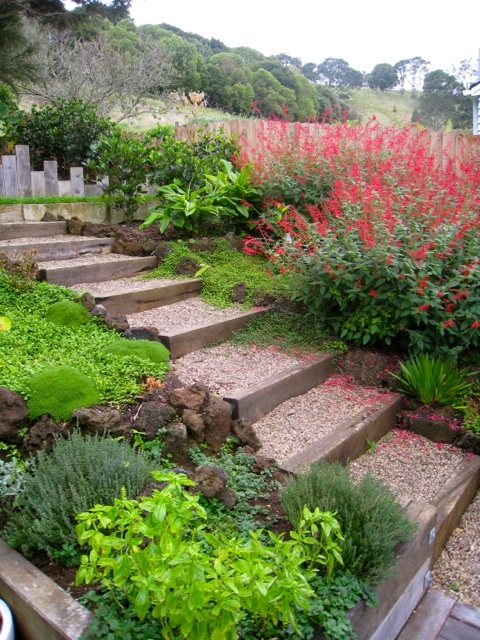
Rachel is senior content editor, and writes and commissions gardening content for homesandgardens.com, Homes & Gardens magazine, and its sister titles Period Living Magazine and Country Homes & Interiors. She has written for lifestyle magazines for many years, with a particular focus on gardening, historic houses and arts and crafts, but started out her journalism career in BBC radio, where she enjoyed reporting on and writing programme scripts for all manner of stories. Rachel then moved into regional lifestyle magazines, where the topics she wrote about, and people she interviewed, were as varied and eclectic as they were on radio. Always harboring a passion for homes and gardens, she jumped at the opportunity to work on The English Home and The English Garden magazines for a number of years, before joining the Period Living team, then the wider Homes & Gardens team, specializing in gardens.
Sloping garden ideas: 20 landscaping and styling solutions for plots on a hill
(Image credit: Amanda Broughton Garden Design)
Finding sloping garden ideas can seem tricky at first.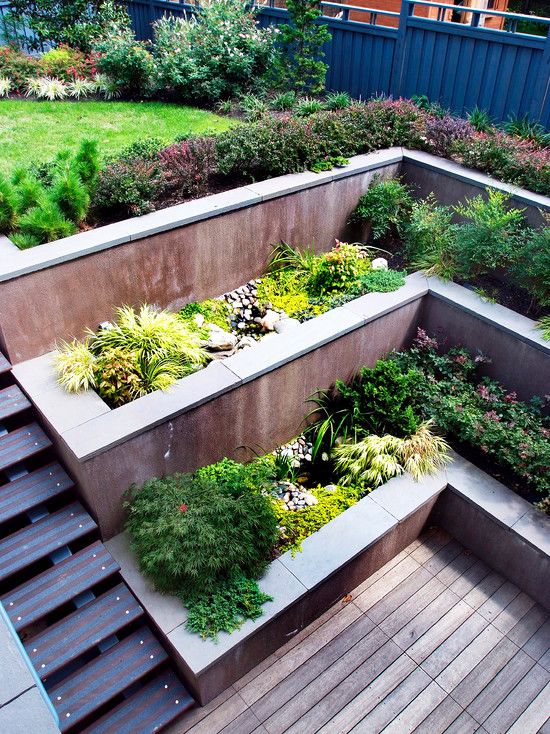 But it turns out that gardens on a hill can offer plenty of opportunities that a flat site simply can't. Yes, a bit more planning is involved, and some professional input when it comes to calculating retaining walls and drainage. Plus, plenty of muscle power is needed when it comes to re-shaping the plot. But, the end results are often some of the most breathtaking and interesting outdoor spaces out there.
But it turns out that gardens on a hill can offer plenty of opportunities that a flat site simply can't. Yes, a bit more planning is involved, and some professional input when it comes to calculating retaining walls and drainage. Plus, plenty of muscle power is needed when it comes to re-shaping the plot. But, the end results are often some of the most breathtaking and interesting outdoor spaces out there.
Choose from super-chic, contemporary plans that include neat tiers, smartly rendered retaining walls, and slick water features, or go for wilder and more relaxed plant-packed borders, informal mown paths and rippling streams. The choice of hard landscaping materials is endless, with each offering distinct characteristics. Even practical necessities such as safety railings, steps and drainage channels can become eye-catching design features, that add personality to the final look.
So, sit back, take a look at our favorite ideas, and then start dreaming up your masterplan for your sloping garden ideas.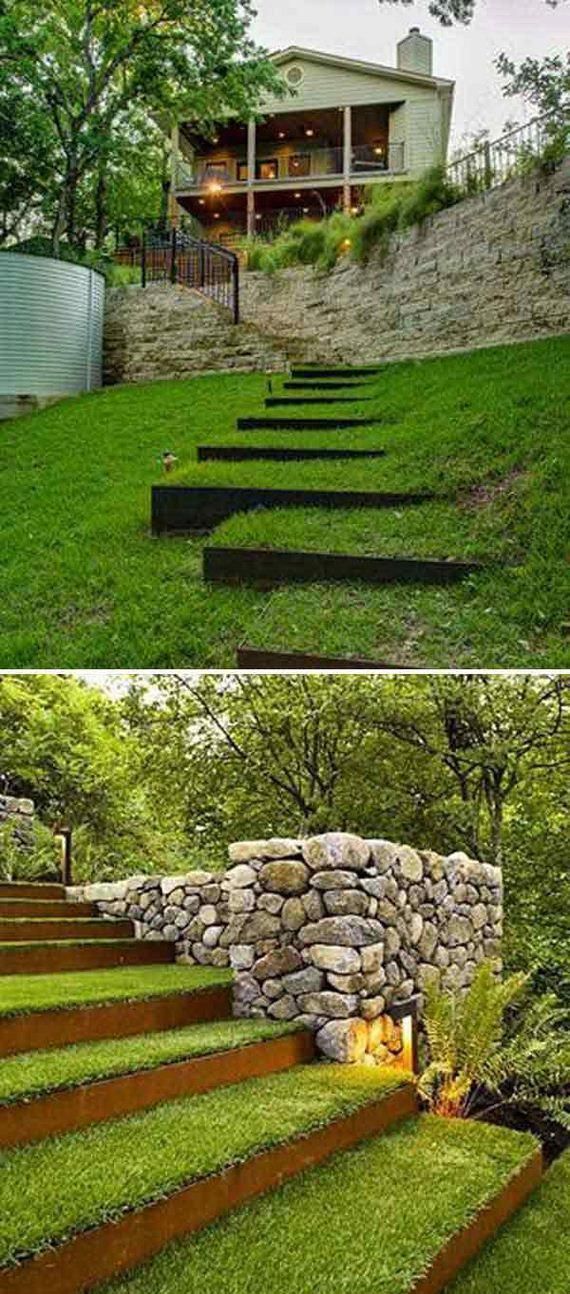 And if you want even more inspiration for your outdoor space, head over to our garden layout ideas feature.
And if you want even more inspiration for your outdoor space, head over to our garden layout ideas feature.
1. Surround a seating spot with levelled borders
Sloping garden ideas can help to show off your borders
(Image credit: Polly Eltes/Future)
Sloping garden ideas can be used to create show-stopping impact, as seen in this plot. The eye is drawn upwards by the wooden-cladded flowerbeds, which cocoon a verdant lawn. Curved steps add to the rustic feel.
Meanwhile, the seating space is given plenty of shelter, positioned on a decked area at the same level as the house. The result is a breathtaking view where all aspects of the garden can be appreciated at once.
Take a look at our outdoor seating ideas for more stunning designs.
2. Brighten the space with pale walls
Garden designed by Living Gardens
(Image credit: Living Gardens)
This tiered plot designed by Living Gardens demonstrates how sloping garden ideas can be used to create a modern, attractive space that all the family can enjoy.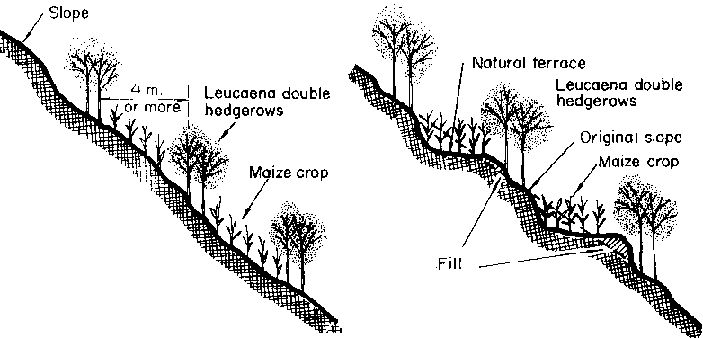
There's plenty of room to entertain on the hardwood deck. Above, a paved seating area is surrounded by a curved planter, which softens the design and provides soothing visual interest. A lush lawn takes up the lower level of the plot.
One of our favorite things about this scene, however, is the choice of materials and colors. The pale hues bounce light around, helping to open up the space and adding to the clean, elegant vibe. The resulting look feels airy and relaxed, and makes a wonderful backdrop to the verdant planting and dazzling agapanthus.
Need more family garden ideas? Take a look at our feature.
3. Add a soothing vibe with curved features
Garden designed by CITYSCAPERS
(Image credit: CITYSCAPERS)
Slopes don't have to be flattened – they can provide character and opportunity for interesting design. This garden has a gentle slope, most of which was kept and turfed, explains Nigel Gomme, Landscape Designer of CITYSCAPERS .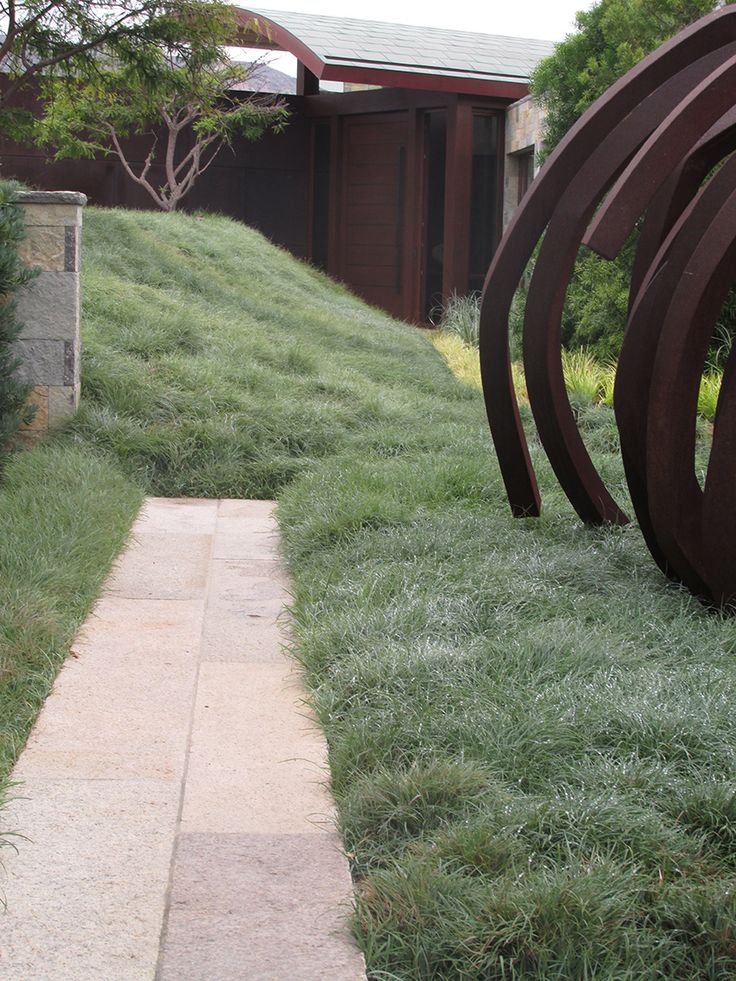
On one side, a series of tiered level beds cuts into the area. These step up in sync with the slope, with a stepped path snaking through them. We love the gentle curves, which are mirrored by the wooden bench. Together, they offer an organic, pleasing vibe.
'On the other side of the lawn, we created a small stream that uses the natural fall in the land to meander down to a pond set into the patio by the house,' Nigel says. 'So in a single garden, the sloping topography of the site is expressed in three contrasting yet complementary ways and mostly, in fact, by keeping the slope.'
4. Try a series of small terraces
Garden designed by Fenton Roberts Garden Design
(Image credit: Fenton Roberts Garden Design)
'You can sometimes flatten a whole garden but you will often be left with a large height difference on one side or at the end,' explains Jo Fenton of Fenton Roberts Garden Design . 'This will require a retaining wall which can be very costly and can introduce issues with overlooking your neighbors. '
'
Jo demonstrates an alternative approach to sloping garden ideas in this gorgeous plot. 'In this garden we worked with the slope by designing a series of small terraces. The slope across the garden is dealt with by introducing two sets of raised beds where the clients grow their vegetables and herbs.' It's functional, stylish, and the shallow levels add visual interest to the garden.
Don't forget to check out our guide to raised garden beds if you want to get started on your own.
5. Plant billowing borders
Garden designed by Fenton Roberts Garden Design
(Image credit: Fenton Roberts Garden Design)
'Sloping sections of a garden can be hidden within the planted areas enabling other areas to be flattened for practical use,' says Jo Fenton of Fenton Roberts Garden Design.
'This steeply sloping garden was too extreme to flatten out entirely. Here, we mixed sloping flowerbeds with two paved terraces and a lawn. A narrow access path bisects this large planted area enabling the maintenance to be carried out. '
'
Adding plenty of height with textural plants adds a sense of romance and drama to the zone. This look would work perfectly as part of our cottage garden ideas.
These Corten Steel garden stairs by Adezz at Flora Select make a striking feature for sloping garden ideas
(Image credit: Flora Select)
Whether you are linking terraces or adding definition to a steep slope, a set of practical and eye-catching steps will help define and add structure to the outside space.
A simple stairway built from blocks, timber sleepers or deckboards will of course do the job but can take up valuable floorspace. Instead, opt for some prefabricated metal steps – such as Corten steel designs – for your sloping garden ideas. Not only do they look rather chic and introduce a gravity-defying edge to any design, but they can hover over borders and have a minimal footprint too.
They make a great choice if you love our modern garden ideas.
7.
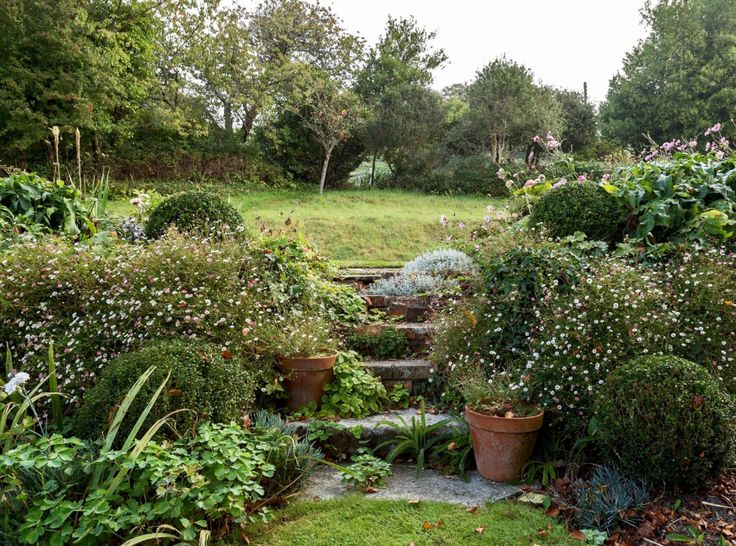 Mix smart steps and sloping beds
Mix smart steps and sloping bedsHardwood decking steps link different areas of this garden designed by Andy Sturgeon and built by Construction Garden Builders
(Image credit: Ben Robert/Blooming Photography/Garden design by Andy Sturgeon/Construction by Garden Builders)
Graceful and easy on the eye – setting steps flush into a planted slope is not just practical but an elegant solution for sloping garden ideas. Solid and distinct, the secret is to make sure the size of each step is right for comfortably strolling up and down and that the width is generous enough to make a bold statement, especially when surrounded with lush planting.
Think carefully about choosing materials and the finished look. In this design, the dark hardwood steps echo the bold windows of the house but keep the look smart, yet organic too.
Looking for more inspiration? Check out our garden steps ideas feature.
8. Use gabions as a retaining wall
This gabion wall is a striking garden feature.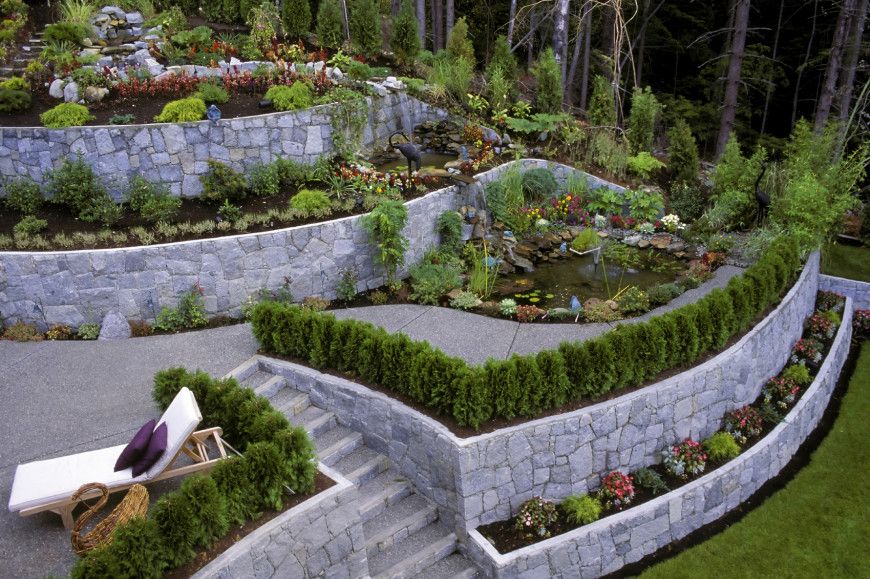 Designed by Andy Sturgeon and built by Construction Garden Builders
Designed by Andy Sturgeon and built by Construction Garden Builders
(Image credit: Ben Robert/Blooming Photography/Garden design by Andy Sturgeon/Construction by Garden Builders)
Retaining walls are key to terracing sloping garden ideas and can become striking garden wall ideas too. There are plenty of options available and these vary widely in cost, planning and installation.
Blockwork walls – rendered or left bare – will require careful planning and preparation, as well as meticulously calculated drainage channels. Stone-filled gabions – such as these pictured – are a handy solution as not only are they strong enough to support hefty banks of soil, they look attractive and crucially let rainwater filter through.
Gabion sizes range from 0.5m to 2m wide baskets and can be made from rigid welded mesh or flexible woven wire.
9. Make room for sunken seating
These black-blue slate walling slips from Bradstone are a smart choice for modern sloping garden ideas
(Image credit: Bradstone)
Introducing tiered garden ideas to a steeply sloping plot is an effective way to manage the space and create a series of small but useable areas too.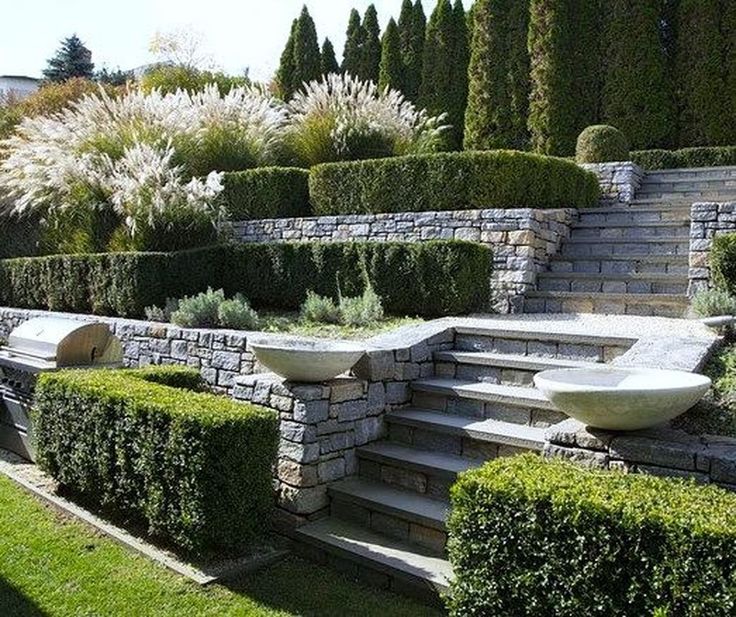 You will need to call in the professionals to calculate the best layout and the size and load of any retaining walls, but the result will be well worth it.
You will need to call in the professionals to calculate the best layout and the size and load of any retaining walls, but the result will be well worth it.
Use your sloping garden ideas to look for clever ways to make the most of limited space. Retaining walls can easily double up as built-in lounge seating and planters so think carefully about the number of guests you wish to accommodate. Keep the decor simple and opt for a super chic stone and timber combo.
10. Build in steps and borders
Keep it sleek and modern with these Casarta slate steps from Marshalls
(Image credit: Marshalls)
Adding return walls to a retaining wall and flight of steps can create a striking feature in steep gardens on a slope. A bold combination of materials – such as this pairing of slate and white rendered walls – adds drama to the finished result.
As well as being supremely practical, it also helps to visually link two contrasting styles of gardening – smart and contemporary on the lower level and soft and wilder at the top.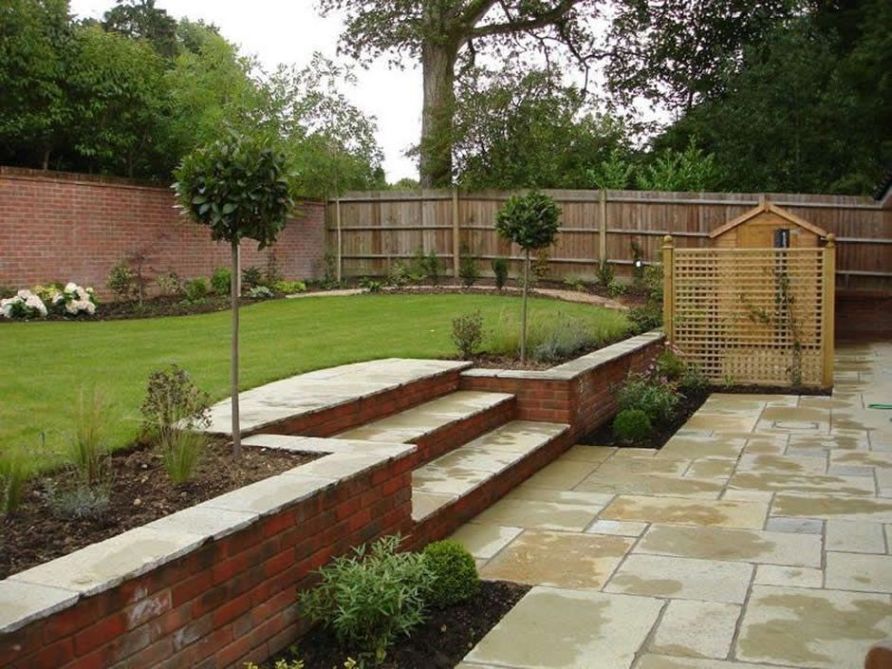 The short return walls also help to showcase the carefully selected border plants.
The short return walls also help to showcase the carefully selected border plants.
11. Go for tiered planters
Jura Beige Limestone Step Treads from London Stone are a timeless choice for any garden scheme
(Image credit: London Stone/Construction by Oakley Landscapes)
Dividing a steeply sloping garden into tiers doesn't have to result in a space that's split up by hard, straight lines. There are plenty of clever ways to soften and blur these divisions, particularly if you're searching for small garden ideas.
One way is to use stepped, angular planters. Or, go for fewer, larger planting pockets for your sloping garden ideas – these could be built into your new landscaping or added as freestanding containers. Fill with tall, airy, year-round planting that will soften the harsh, straight lines without casting heavy shade. There's lots of expert advice on designing flowerbeds in our guide to garden borders.
12. Divide with sweeping curves
This beautiful garden designed by Amanda Broughton Garden Design uses sweeping paths and stone walls as part of its sloping garden ideas
(Image credit: Amanda Broughton Garden Design)
Disguise a steep but sizeable plot by introducing sweeping garden path ideas and an equally curvy retaining wall to your sloping garden ideas.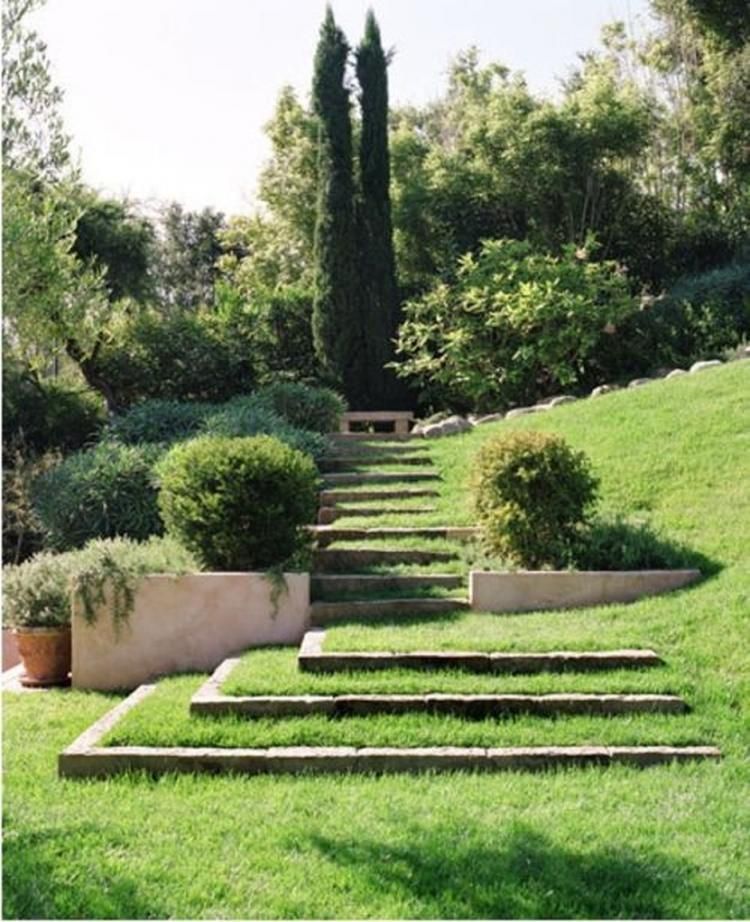 Not only does this subtly divide up the sloping site into a series of terraces, but it also adds a sense of horizontal movement too.
Not only does this subtly divide up the sloping site into a series of terraces, but it also adds a sense of horizontal movement too.
In this beautiful design, a snaking stone wall creates a cozy seating area and also provides the opportunity for a falling water feature.
13. Add character with railings
This garden on a slope was designed by Lindsey Evans Garden Design
(Image credit: Linsey Evans Garden Design)
Steep, terraced gardens on a slope must comply with building and safety regs but it's also a great excuse to invest in some super stylish railings. Choose from off-the-peg or handcrafted, bespoke designs to complement your garden's style and setting.
With so many different materials and finishes to choose from, it's worth researching the options before committing for your sloping garden ideas. Polished stainless steel and aluminium tubular designs give off a truly contemporary and nautical feel whereas wrought iron is much more traditional and ornate in its possibilities.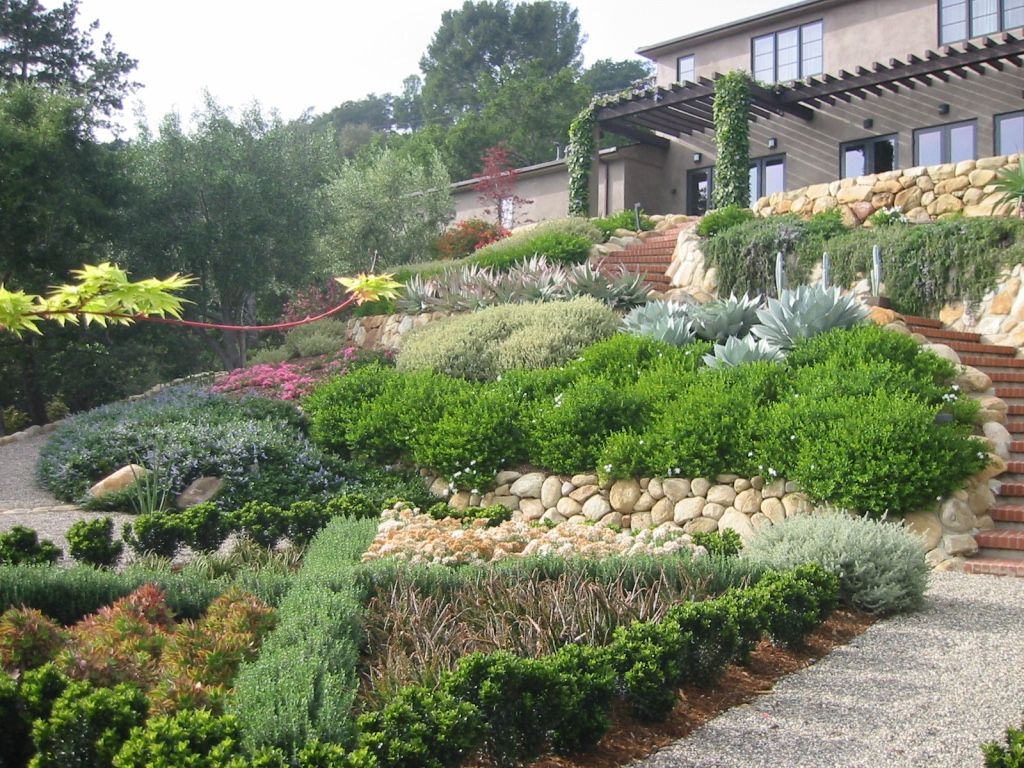
Fancy a pop of color? Then go for powder-coated steel railings that can be finished in one of hundreds of RAL shades. Wood, tension wire between wood and metal posts and even toughened glass are also stunning options. We have lots more inspiration in our decking railing ideas feature.
14. Use sloping garden ideas to showcase planting
Large flowerbeds and varied planting are key features of this sloping garden by Acres Wild Garden Design
(Image credit: Acres Wild)
A garden that slopes up from the house or patio is the perfect opportunity to show off beautiful planting. Keep your landscaping ideas to a minimum – a flight of timber steps or duckboards leading from A to B will link and punctuate the space without taking away from the planting.
When it comes to planning borders for your sloping garden ideas, introduce layers of shrubs and trees for year-round form and structure. Then, fill in the gaps with vibrant and textural perennials and ornamental grasses.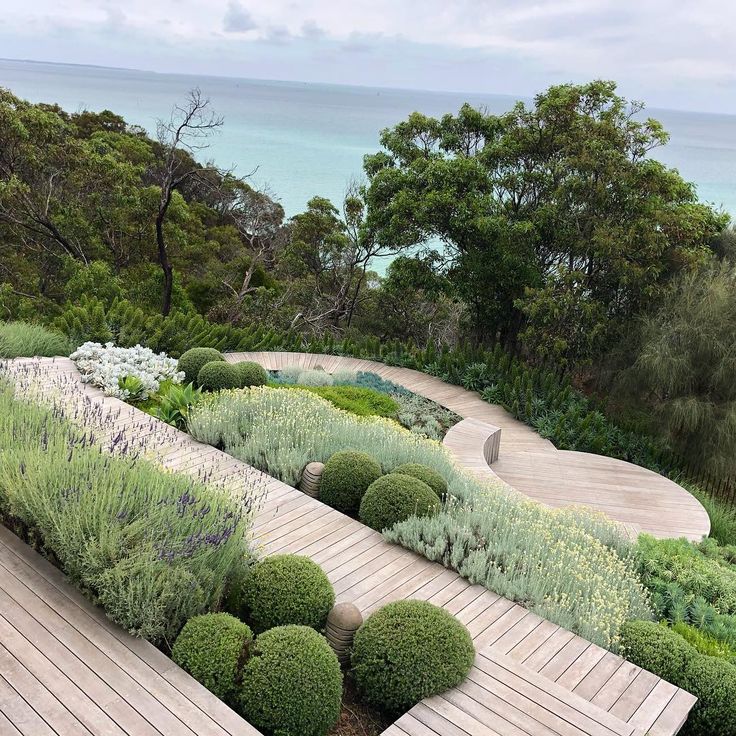
Encourage low-growing evergreens and foliage to spill over and soften the hard edges of any steps, patios or retaining walls, and use climbers over fences to complete the abundant look.
15. Terrace with easy-care decking
Cladco’s Hollow Stone Grey and Black Charcoal Solid Bullnose Decking Boards were installed in this garden by Gull Rock Decking
(Image credit: Gull Rock Decking)
The best composite decking is a smart, no-fuss and versatile material – perfect for creating steps and usable levels in a sloping garden.
Needing less upkeep than timber deck boards, these vinyl-wrapped planks come in a wide variety of finishes and profiles and can be easily installed to suit your individual site.
Head over to our decking ideas feature for more inspiration.
16. Take a soft approach
This large garden by Acres Wild Garden Design has a beautiful, natural feel to its landscaping design
(Image credit: Acres Wild)
Gardens on a slope can be given a wild touch by playing it simple and keeping hard landscaping to a minimum.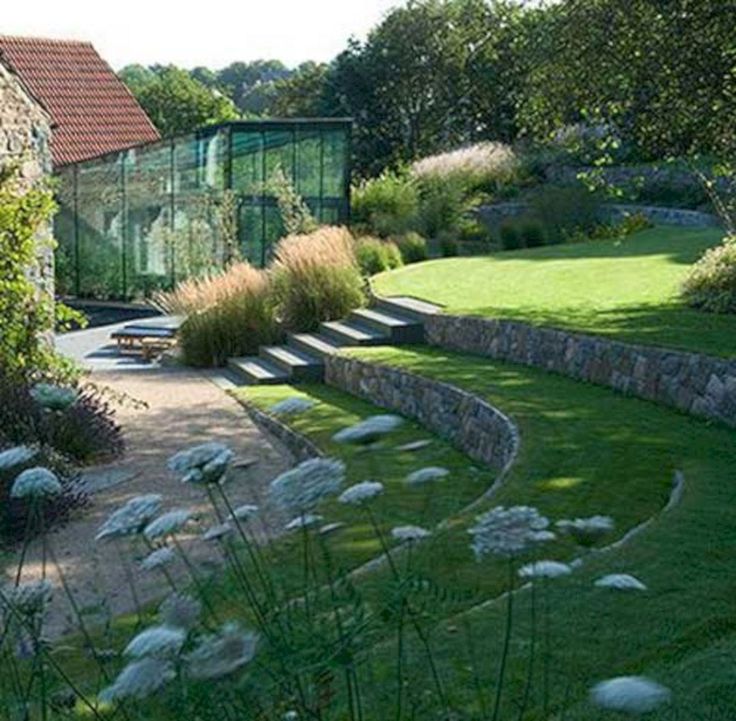
If you have a gentle slope, a neatly mown path leading through a flower-laden meadow is an elegant solution that puts nature and natural form centre stage. Add some drama to the look by keeping the layout symmetrical. Then, place a striking sculpture or one of the best garden benches at the far end of the path – a perfect solution for long garden ideas on a slope.
17. Dig out a sunken patio
Designed by Nordland Landscapes , this garden makes the most of its sloping plot
(Image credit: Krisztian Sipos Photography/Garden design by Nordland Landscapes)
Maximise your garden's usable space by digging out the base of the slope to create a sunken patio. An enclosed seating area instantly creates a cozy feel and offers an extra degree of shelter and warmth, so is perfect for those cooler months.
A retaining wall will have to be planned and constructed by a garden designer or landscaping professional to ensure it can support the weight of soil behind it and deal with any resulting drainage issues. This smart, urban design involved installing a hidden slot drain to handle any sudden downpours.
This smart, urban design involved installing a hidden slot drain to handle any sudden downpours.
Find more patio ideas in our guide.
18. Include falling water
A modern water feature links different areas of this garden designed by Susan Dunstall
(Image credit: Susan Dunstall Landscape and Garden Design)
Gardens on a slope – whether they're terraced or left angled – provide the ideal opportunity to bring in flowing water. It could be a gently babbling stream that meanders down through rocks and is niftily recycled back to the top by a hidden pump and water reservoir, or something decidedly more contemporary.
In this eye-catching garden, the very steep site is divided into two distinct levels with a pair of stunning water chutes and a raised pond built into the lower wall. If you want to incorporate something similar in your garden design, you'll find plenty of inspiration in our water feature ideas gallery.
19. Reinvent the rockery
This modern take on a rockery was designed by Wildroof Landscapes
(Image credit: Jo Crompton Photography/Garden design by Wildroof Landscapes)
Let the beauty of natural stone and Japanese gardens inspire you to transform a dull, sloping site.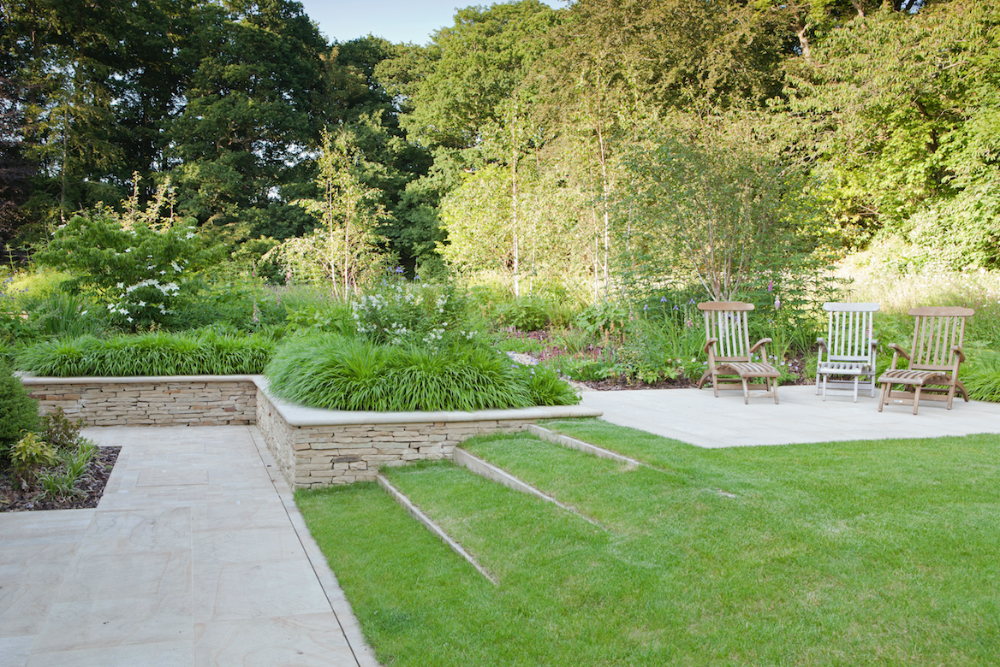 Fine gravel paths weaving through rocky borders planted with low-growing sedums, alpines, azaleas and statuesque conifers provides beautiful year-round color and interest. And, it creates an instantly calming mood, too.
Fine gravel paths weaving through rocky borders planted with low-growing sedums, alpines, azaleas and statuesque conifers provides beautiful year-round color and interest. And, it creates an instantly calming mood, too.
This Japanese inspired tea garden by Wildroof Landscapes is a crevice garden full of character and texture. Local stone laid side on and packed close together makes a bold contrast with laid dry-stone walls and boulder-edged planting areas.
If you love the look, be sure to check out our small Japanese garden ideas, too.
20. Go on – add a slide!
This family garden designed by Eldridge London turns the sloping nature of the plot into a fun garden feature for the kids
(Image credit: Lyndon Douglas/Garden design by Eldridge London)
There's no need for an excuse – every sloping garden surely has to have a slide built in! It could be a colorful moulded or aluminium children's version that you bed neatly into a grassy bank, but why not go all out and choose a beautifully-crafted design that everyone can enjoy?
This gorgeous garden includes intricate cedar-clad planters, a lawn, and angled steps.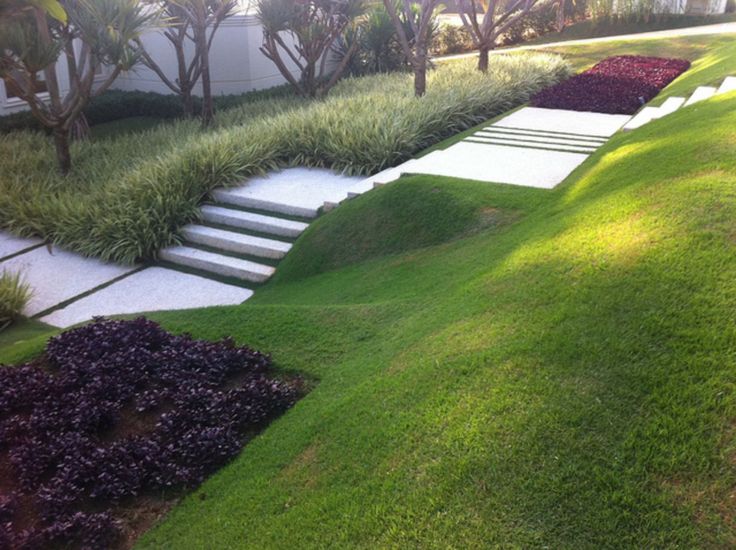 The stainless-steel slide is extra wide and adds a minimal but striking feature for uber-modern gardens on a slope.
The stainless-steel slide is extra wide and adds a minimal but striking feature for uber-modern gardens on a slope.
We've got plenty of ways to keep kids entertained outdoors in our garden activities for kids feature – head on over to take a look.
How do you drain a sloping garden?
When it comes to providing drainage for your sloping garden ideas, 'Soakaways (essentially a hole in the ground filled with rubble) are a brilliant, sustainable option,' says Garden Designer Jonathan Martin of Living Gardens.
This is because, 'You're not sending excess water into drainage but taking it away from the surface to soak into the soil below.'
Can you flatten a sloped garden?
Sloping garden ideas can be brought to life with gorgeous garden lighting, like in this garden designed by Living Gardens
(Image credit: Living Gardens)
Completely flattening a significant slope is difficult (and generally, expensive). But instead, you can opt for multiple levels, as Garden Designer Jonathan Martin of Living Gardens explains.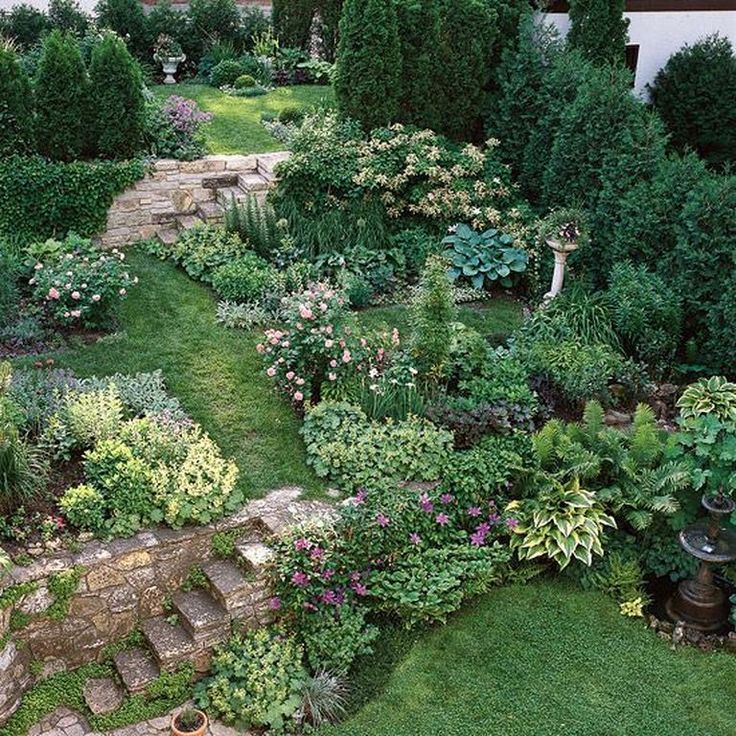 ..
..
'You can't easily change the difference in height between the top and the bottom of your garden, so what we usually opt for is a tiered design,' he says.
'In the pictured garden, the gradient was so steep that we needed to step down three steps straight out of the house. This is followed by two tiers down to the lawn. Even then the lawn slopes, so to deal with drainage we dug two soakaways, one a third of a way down the lawn, and one two thirds of the way down, to take the excess water away from the surface.' We adore the use of garden lighting ideas here, too.
Nigel Gomme, Landscape Designer of CITYSCAPERS adds, 'A sloping garden is typically viewed as problematic but as a designer I love slopes as they embody a kind of three dimensional potential that can lead to unique and really engaging spaces.'
'You can cut into a slope, you can cantilever out over it, you can add a rubber liner and rocks and pebbles and run water down it to create a stream – there's so much latent potential to explore.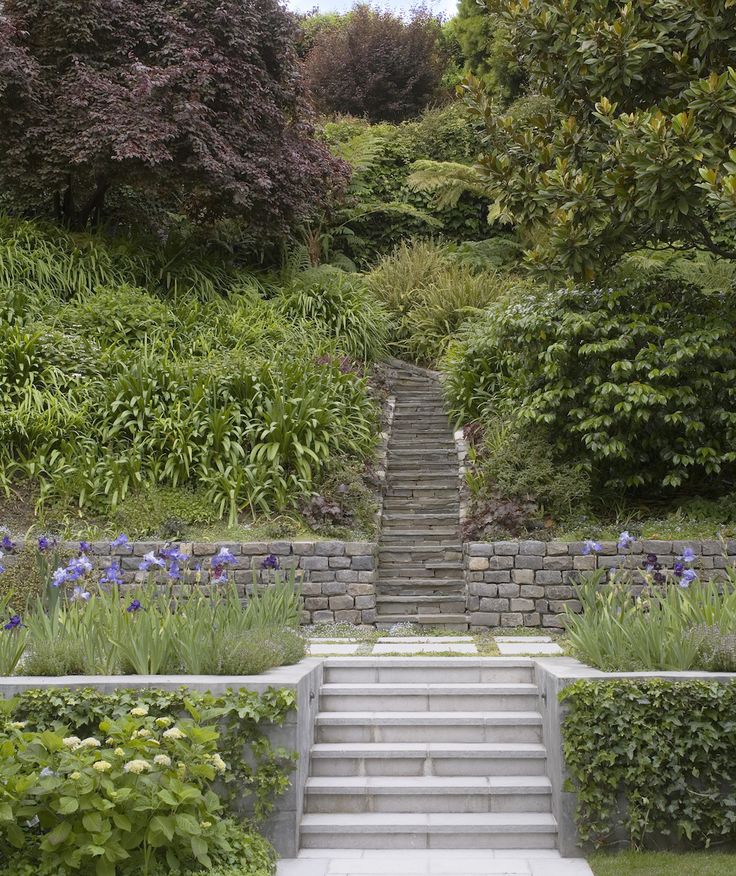 So my advice would be don't rush to flatten it – think of a slope as a resource rather than a problem and be inventive in how you engage with it.'
So my advice would be don't rush to flatten it – think of a slope as a resource rather than a problem and be inventive in how you engage with it.'
Do I need permission to level my garden?
Clever sloping garden ideas can include fabulous terraced structures, like in this garden designed by CITYSCAPERS
(Image credit: CITYSCAPERS)
In general, you don't need permission to level your garden as part of your sloping garden ideas. 'But there are caveats,' says Nigel Gomme, Landscape Designer of CITYSPACERS. 'The first thing you need to consider are trees within the garden. Changing soil levels within their root zones, which are generally twice as wide as the canopy, can damage or even kill trees,' he explains. 'If there are tree protection orders on any trees within your garden you could be breaking the law. So, it is well worth seeking professional advice before you start.'
'Other things to consider include boundary walls and fences. How will level changes within the garden affect your neighbor's wall or fence, for example? If you’re dropping the ground level quite a bit, boundary walls may need underpinning which is an expensive undertaking. '
'
'However, with thought, there can be ways around some of these problems. We recently landscaped a garden [see above] that steeply sloped away from the house and was also pitched to the side, with protected trees throughout,' Nigel continues. We couldn't change soil levels, build walls or lay paving within the root zones of the trees and the client wanted level surfaces. So, we built raised platforms, decks and walkways that appear to float over the sloping landscape: the trees were unharmed, attractive practical level areas were created for entertainment and outdoor dining, and the sloping terrain was basically left untouched. The point here is that to level a garden you don't necessarily have to level the ground itself, you can build level structures above it instead.'
Looking for more inspiration? Head over to our guide on landscaping around trees.
Garden Designer Jo Fenton of Fenton Roberts Garden Design adds, 'We often encounter the problem of a steep drop from the house into the garden leaving people feeling disconnected from their outdoor space. This can be solved by adding a raised terrace to the back of the house. However, if this raised area is over 30cm above ground level you will often have to apply for planning permission. This is because the terrace may overlook your neighbors.'
This can be solved by adding a raised terrace to the back of the house. However, if this raised area is over 30cm above ground level you will often have to apply for planning permission. This is because the terrace may overlook your neighbors.'
Jill puts her love of plants and all things garden related down to the hours spent pottering around with her Nan and Grandad when she was little. Today she is lucky enough to have a garden of her own in Surrey, England, and spends much of her time writing about them too.
Landscape and slope design
Landscape and slope designLLC "PozitivProekt"Landscape design and gardening
Send an application
- Home
- Articles
- Landscape architecture
- Landscaping of a site on a slope
Landscaping of a site on a slope is always associated with non-standard solutions. On the one hand, such a territory creates some difficulties for the designer, but on the other hand, it is a great opportunity to demonstrate creativity and professionalism. In the end, complex tasks are always interesting. nine0003
Peculiarities of the site on a slope
Sites on a slope differ in that the relief of each is individual. It is the existing properties of the site that set the direction of thought for the designer. The uneven terrain opens up a number of possibilities for the designer that should be used in the work:
- If you build a house on the highest point of the site, then all the properties will be visible from the windows, this view will create a special atmosphere of soaring above the world in the house.

- The slope is ideal for arranging a waterfall, a water cascade or an alpine slide on it. nine0008
- The land on the southern slope can be used for planting heat-loving crops.
At the same time, according to the many years of experience of the PozitivProekt specialists, there are objects on the location of which the relief imposes certain restrictions:
- A lawn can only be placed on a slope with a slight slope.
- On the north side, heat-loving crops will not take root or will not produce the desired crop. nine0023 In the absence of a drainage system, it is impossible to locate a house in a lowland, as there is a risk of flooding in the spring or during heavy periods.
- It will be difficult to grow moisture-loving plants on a slope, as their watering needs will be many times greater, because the water on such a relief will flow down without lingering in the soil.
Additional landscaping requirements for a slope site are safety related.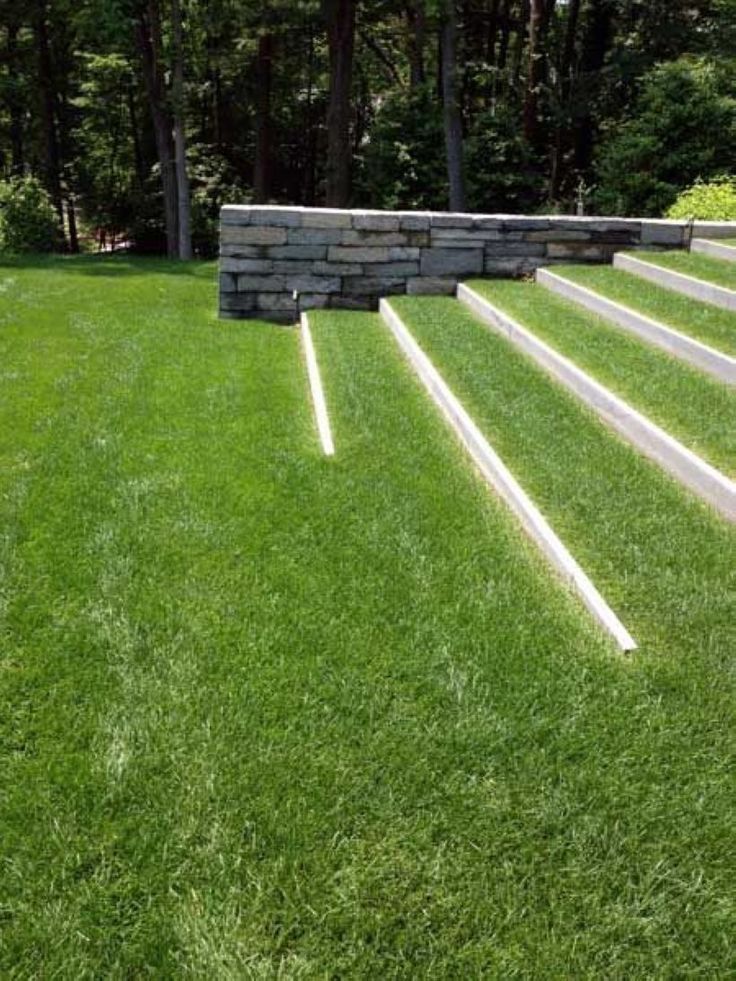 It is necessary to think over a system of paths for the movement of children and the elderly, providing them, where necessary, with handrails. In addition, it is necessary to protect the soil from erosion during rains, to strengthen unstable areas. Of course, all these activities require additional financial investments, so the owners will have to spend money to equip the plot on the slope. nine0003
It is necessary to think over a system of paths for the movement of children and the elderly, providing them, where necessary, with handrails. In addition, it is necessary to protect the soil from erosion during rains, to strengthen unstable areas. Of course, all these activities require additional financial investments, so the owners will have to spend money to equip the plot on the slope. nine0003
Landscape design of a site on a slope
When working on the design of such a garden, the following factors will need to be taken into account:
- Orientation of the slope to the cardinal points . Depending on whether the elephant is southern, eastern, northern or western, the illumination on the site will be different, the sun will appear more often or less often and mainly at different hours of the day. Of course, first of all, this factor affects what plants you will place on your site. For example, the southern slope is illuminated throughout the day, the sun begins to warm here from the earliest spring, the snow melts faster.
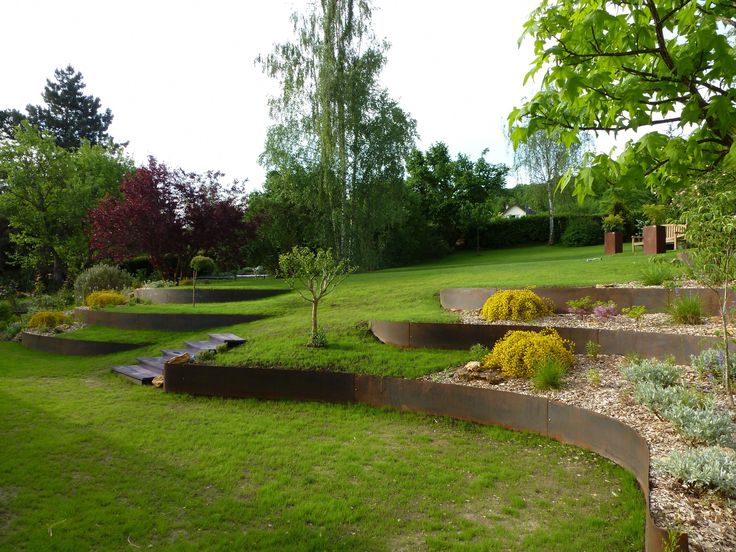 However, in dry times, the soil suffers more from the lack of moisture and requires increased watering. Accordingly, in such a plot, the owners can afford to plant more heat-loving plants, and it is desirable that they are drought-resistant. nine0052 There is much less sun on the northern slope, so shade-loving cultures will feel better here.
However, in dry times, the soil suffers more from the lack of moisture and requires increased watering. Accordingly, in such a plot, the owners can afford to plant more heat-loving plants, and it is desirable that they are drought-resistant. nine0052 There is much less sun on the northern slope, so shade-loving cultures will feel better here.
- Plot angle . This parameter declares which structures are suitable for facilitating movement in the garden. Usually, stairs, retaining walls, terraces are in demand on such a relief. The number of terraces, the choice between stairs and a serpentine path, the height of the steps of the stairs, the presence and absence of railings, the height of retaining walls, etc. will depend on the angle of inclination. nine0052 Landscape designers of the PozitivProekt company (Moscow) remind that as the angle of slope increases, so does the force of soil erosion, which will inevitably occur if the fertile layer begins to be washed down by downpours.
 Accordingly, all structures and landings should be thought out in order to strengthen the slope.
Accordingly, all structures and landings should be thought out in order to strengthen the slope.
- Direction and strength of winds in the area . The specificity of the inclined relief will be the increased movement of air masses along the slope. As you know, warm air is lighter than cold air, therefore, below, in the hollows, it is much colder. Evenings are less comfortable in low-lying areas, and ground frosts are more likely in spring and autumn. These are the same patterns for all sites on the slope. nine0052 In addition to them, northeast or southwest winds can dominate in a particular area. Since the strength of the winds on a slope is greater than on flat areas, especially since they usually try to build a house on a hill, these individual features should be taken into account when designing it. With frequent and strong northerly winds, the thickness of the walls should be increased and, if possible, the number of windows on the corresponding side of the house should be reduced.

Terracing a site on a slope
It is difficult to imagine a plot on a slope without terraces and retaining walls. If the slope of the site is more than 15 degrees, then the terraces become simply a necessary element. The terrace is a small horizontal platform, reinforced with a retaining wall from the side of the slope. From the outside, you can build fences. The number of terraces and their height is determined by the area of the site and the slope angle.
If there are several terraces, they are connected by steps or paths. On some terraces, viewing platforms or recreation areas are equipped. The result is a single system of very comfortable and spectacular looking flat islands on the slope. nine0003
Usually, the same type of materials are selected for the entire complex of terraces. For example, natural stone in the retaining wall is complemented by the same paving of the floor of terraces and stairs. In this case, the choice of material is made on the basis of the general style decision.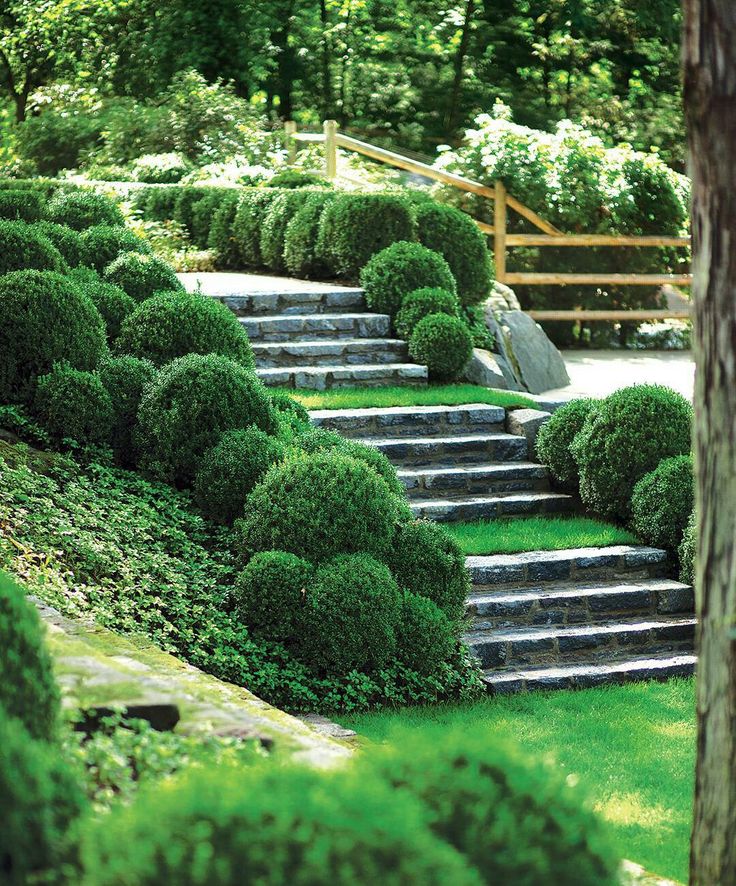 Wood is suitable for a rustic style, forging and brick for modern style, and stone for classics.
Wood is suitable for a rustic style, forging and brick for modern style, and stone for classics.
Constructing terraces, it is necessary to set specific tasks:
- prevention of soil erosion and creation of a thoughtful system of moisture removal; nine0008
- zoning and arrangement of places for various purposes: for recreation, for growing fruits and vegetables, for children's games, for barbecues, etc.;
- laying convenient routes, following which, it will be possible to move around the site.
The construction of terraces begins with the design of the location and size of each. This may be a series of sites located strictly one under the other, there may be a checkerboard arrangement, or it may be arbitrary, asymmetric, natural, as if these objects were not conceived by man, but created by nature itself. After an artificial change in the existing relief, the construction of the upper terraces begins in the first place. The technique is to use the earth cut when creating the upper platforms to create retaining walls for the lower objects. nine0003
nine0003
A separate topic is the construction of stairs. First of all, they should be safe, it should be convenient to move around them. To do this, it is necessary to clearly calculate the width, depth and height of the steps. In addition, the length of the stairs should not be too large: if there are more than 15 steps, then it is worth dividing each flight of stairs with platforms. The areas between the stairs can be decorated with a small flowerpot with flowers or a decorative tree, a garden sculpture or even a bench. Steep and long stairs are best provided with handrails. nine0003
Landscaping
In the process of landscaping a site on a slope, landscape designers of the PozitivProekt company recommend following several rules:
- etc., it will be correct to place it right there.
- It would be appropriate to decorate the upper part of the slope with tall ornamental shrubs. Lilac, barberry, hawthorn, acacia will not only set decorative accents, but will also help preserve the fertile soil layer.
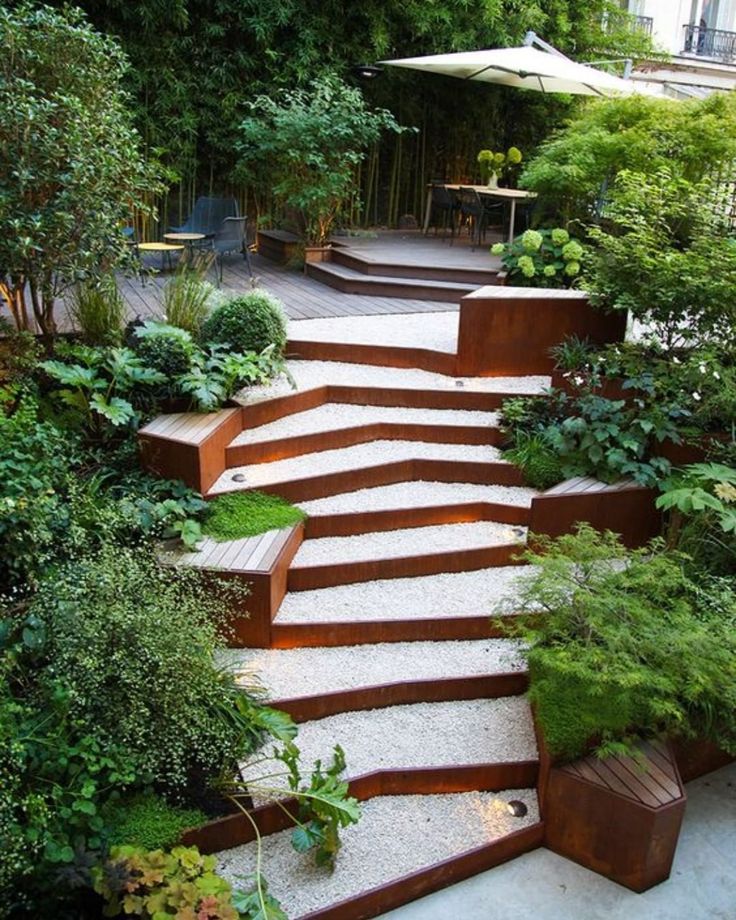 The main rule here: they must not close the house. nine0008
The main rule here: they must not close the house. nine0008 - In the lower part of the slope there should be more compact shrubs, dwarf trees, as well as flower beds, alpine hills, rockeries, etc. Flower beds on the slope also acquire their own unique interpretations, for example, multi-level flower beds do a good job of decorating such a relief.
- Home
- Articles
- Landscape architecture
- Landscaping of a site on a slope
Landscaping of a site on a slope
Landscaping of a site on a slope will require a lot of time and labor.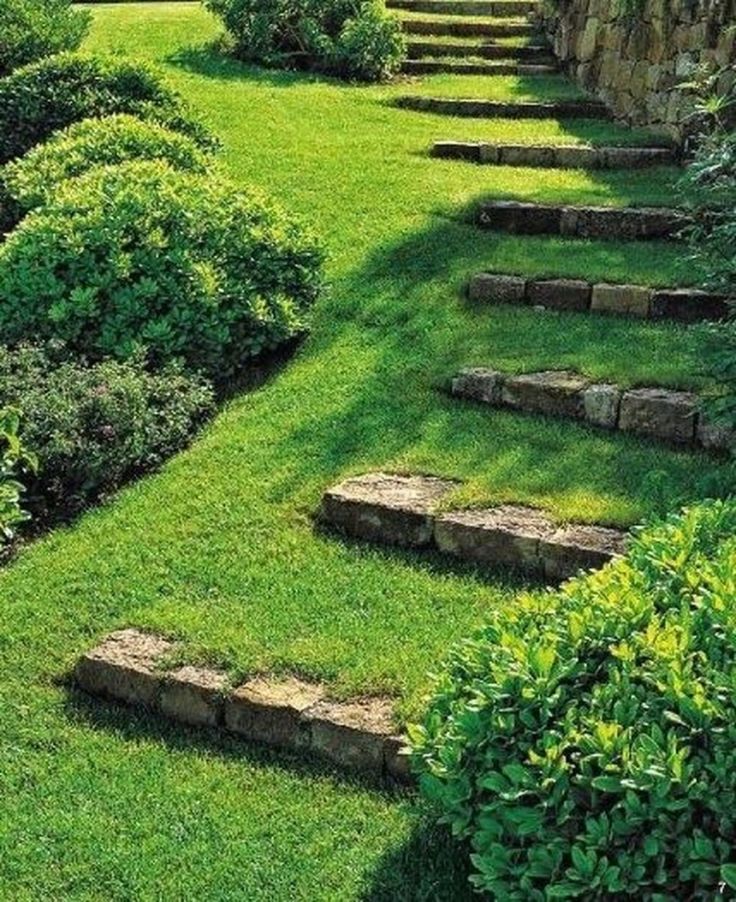 But do not try to level the relief. Thanks to the height differences, it gives landscape designers the freedom to fly their imaginations and the opportunity to realize the most daring and daring ideas. As a result, an area with uneven terrain will look original and spectacular.
But do not try to level the relief. Thanks to the height differences, it gives landscape designers the freedom to fly their imaginations and the opportunity to realize the most daring and daring ideas. As a result, an area with uneven terrain will look original and spectacular.
Topographic survey
Several factors must be determined in order to carry out the work correctly:
- slope angle;
- depth of groundwater;
- type and other features of the soil, the force of its pressure on the hill;
- areas requiring strengthening;
- whether there is a danger of washing away if there is a reservoir nearby.
To obtain detailed information about the relief, a topographic survey is carried out.
If the slope does not exceed 3%, then the site is classified as flat. If it is larger, then they talk about the slope, which is small (up to 8%), medium (up to 20%) and large (more than 20%). Slopes with a large slope are called steep. nine0003
nine0003
Strengthening slopes
Before landscaping, it is necessary to strengthen the slopes in order to prevent destructive processes (erosion) in the upper soil layer and to avoid slipping or collapse of the slope. To strengthen the slopes, a variety of materials and structures are used, among which the most popular are logs, stones, concrete blocks, biomats, lawn grates.
Depending on the features of the relief, the optimal material is selected.
- On small slopes, trees and shrubs with a developed root system or ground cover plants will help to solve the problem. Hawthorn, juniper, barberry, elderberry, blackberry, broom, lilac, quince, ivy, periwinkle are best suited to achieve the goal. nine0008
- Durable and easy way - a fence made of bricks or concrete slabs.
- It is possible to dig in stones or logs, having previously equipped the drainage system.
- Geotextiles are recommended for large slopes. This material is characterized by increased plasticity and water permeability, ease of installation.
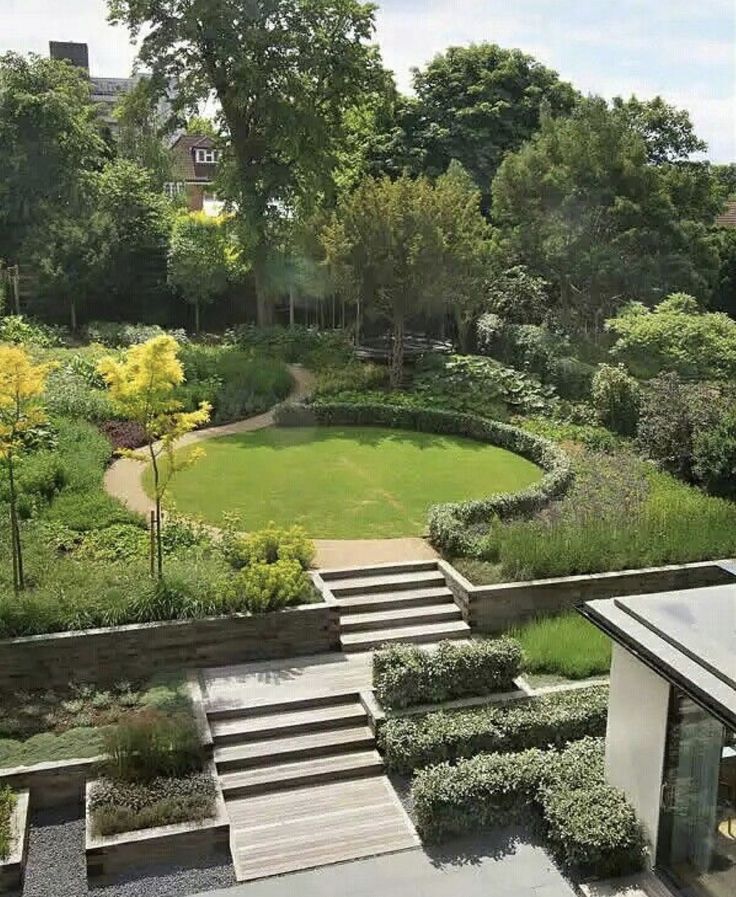 In addition, it will protect the soil from freezing.
In addition, it will protect the soil from freezing. - On particularly steep slopes, gabions and retaining walls are installed, reinforcement is carried out using geomats, geogrids, geogrids. For a gabion, a metal frame is made in the form of geometric shapes, inside of which pebbles, crushed stone, and stones are placed. Soil is poured on top. nine0008
Drainage of the site
After strengthening the slopes, drainage should be laid, which will solve several problems:
- drain excess water from the foundation to prevent cracks in the walls of buildings;
- rid the basement and basement of moisture, dampness and mold;
- prevent moisture stagnation, which will have a beneficial effect on plant growth;
- avoid puddles - even after heavy rain you don't have to wear rubber boots. nine0008
Basic landscaping methods
The following methods are most often used in landscaping:
- Terracing
Horizontal platforms (terraces) are formed on the slope, on which the main zones are located.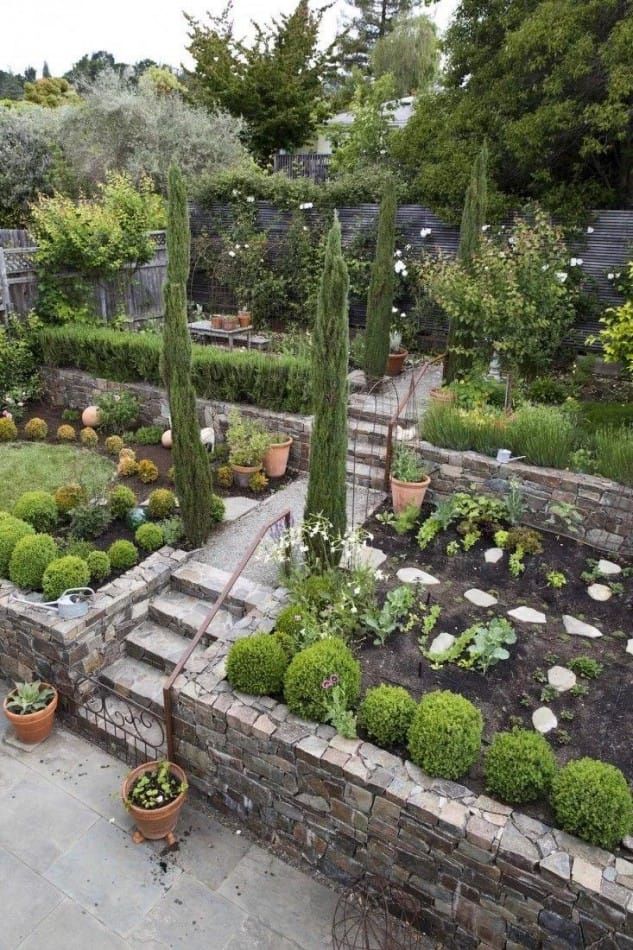 This method allows you to equip even the most hopeless site. You can partially save the relief and combine it with terracing. For example, make terraces on the playground, and plant a garden on a small slope. nine0003
This method allows you to equip even the most hopeless site. You can partially save the relief and combine it with terracing. For example, make terraces on the playground, and plant a garden on a small slope. nine0003
Do not make the terraces even and give them the same size. If they differ and are located randomly, then the site will look more spectacular. To make the design unique, it is recommended to decorate each site in a different style.
Connect terraces with steps.
- Floristry (planting flower and ornamental plants)
Vast scope for the realization of the most incredible ideas is provided to lovers of flowers. Difficult relief will allow you to equip any flower beds: raised flower beds, rockeries, rock gardens, flower borders. nine0003
- Paving paths, making steps and stairs
Winding rather than straight paths look the most harmonious. They are placed on a relatively flat surface, providing a smooth descent and ascent.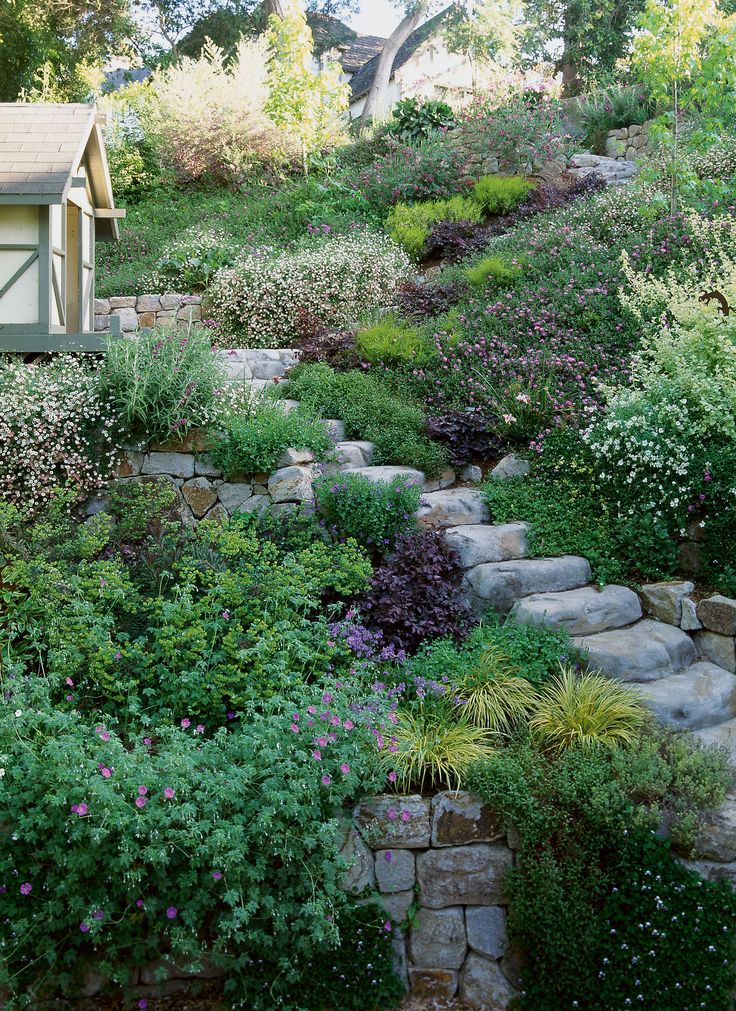 You can combine long and gentle climbs with short and steep ones.
You can combine long and gentle climbs with short and steep ones.
Steps and ladders, preferably divided by platforms, will help to facilitate the ascent. On the site you can put a bench, garden sculptures, flower pots.
It is recommended to install ramps on utility paths to facilitate the movement of garden equipment. nine0003
- Creation of a stream with cascades or numerous waterfalls and ponds.
Conclusions
In order to equip a site on a slope, it is necessary:
- to perform zoning of the territory;
- reinforce the slope;
- protect the soil from erosion processes by equipping the drainage system;
- to improve the territory with the help of terracing and floristry.
But such work requires deep theoretical knowledge and certain practical skills. Therefore, the best choice would be to contact the landscape workshop. The specialists of the "Garden of Fantasy" will realize your wishes and turn a non-prestigious site into a piece of paradise.